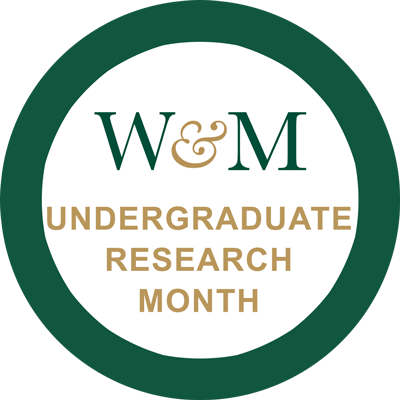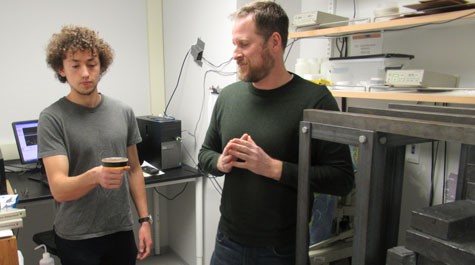Cold War legacy: A spring break assignment evolves into investigation of cesium-137 in U.S. honey
Work that began in 2017 as a spring break assignment for members of a William & Mary freshman seminar unexpectedly blossomed into a serious investigation into the presence of a radioactive isotope in honey in the eastern U.S.
The isotope is cesium-137, a relic of atom bomb tests conducted during the Cold War. Jim Kaste, an associate professor in the university’s Department of Geology, reports that 68 of 122 honey samples from Maine to Florida show varying amounts of cesium-137.
 Cesium-137 contamination of food raised concerns following the nuclear incidents at Chernobyl and Fukushima, but Kaste said that the levels of cesium-137 he’s found in honey is far below the levels that prompted authorities to pull food from the market after those nuclear plant disasters.
Cesium-137 contamination of food raised concerns following the nuclear incidents at Chernobyl and Fukushima, but Kaste said that the levels of cesium-137 he’s found in honey is far below the levels that prompted authorities to pull food from the market after those nuclear plant disasters.
“I’m not trying to tell people they shouldn’t eat honey. I feed my kids honey,” Kaste said. “I eat more honey now than I did when I started this project.”
The research was published in “Bomb 137Cs in modern honey reveals a regional soil control on pollutant cycling by plants,” in the journal Nature Communications. Co-authors are Andrew J. Elmore of the University of Maryland Center for Environmental Science and Paul Volante ’20, who was a member of the COLL 150 seminar that uncovered the phenomenon.
A multistep hypothesis
Kaste offers a multistep hypothesis of how cesium-137 moved enormous distances — even crossing the Pacific Ocean — to end up in jars of honey from hives on America’s east coast. The hypothesis also addresses why cesium-137 tends to show up in some areas more than others.
Cesium-137 is a byproduct of uranium-plutonium fission, a component of the fallout from H-bomb test explosions conducted by the U.S. and the Soviet Union at sites ranging from New Mexico and Nevada to the Marshall Islands and the Russian Arctic archipelago Novaya Zemlya. The bomb tests varied in magnitude and Kaste said it’s impossible to determine the precise bomb that produced the cesium-137 found in any region, let alone any specific jar of honey.
“But we know that the cesium-137 production from the Pacific and Russian sites was more than 400 times the production of the New Mexico and Nevada explosions,” he said. “A single Russian bomb, the Tsar Bomb, was more than 50 times more powerful than all the Nevada and New Mexico tests combined.”
Kaste explained that what didn’t fall to earth near the test sites drifted along high in the atmosphere — and into the stratosphere in the case of the larger explosions. The prevailing winds bore the cesium eastward until the isotope was brought to earth by the plentiful rainfall of the eastern U.S.
Kaste’s examination of single-source honey showed some trends. For instance, honey samples from the Virginia Piedmont were virtually cesium-free. By comparison, honey from North Carolina southward commonly showed the presence of cesium-137. Florida honey was especially “hot.”
Cesium levels were mixed from Virginia north,— but curiously, began showing up again in Maine.
“I talked to a beekeeper in Maine, and he told me they send their hives south for the winter,” Kaste said. “Maine gets too cold for bees.”
It’s the soil chemistry
As the cesium was brought to earth by rainfall, it would make sense that the areas with the highest annual precipitation would tend to produce cesium-laced honey. But such was not the case. The secret to the cesium-honey connection, the collaborators found, was in soil chemistry, particularly the potassium content.
The researchers plotted their honey samples atop a map showing potassium levels in each county. They found a definite and inverse correlation: cesium-laced honey was coming from low-potassium soils, such as those prevalent from the Carolinas on down.
“Potassium is an important nutrient for plants,” he said. “And potassium and cesium atoms look very similar.”
Plants looking for potassium were taking up the cesium, Kaste explained, adding that the substitution didn’t happen where the soil was potassium-rich. But in low-potassium soil, the plants take up what appears to be the next best thing, passing it along through nectar to the bees. The bees biomagnify the cesium in the honey-making process.
The honey probe had its genesis in GEOL 150: Radioactive Pollution. Kaste said he realized that his students — and maybe even the parents of his students — had no experience of atom-bomb anxiety, the bomb tests and the school Civil Defense drills that followed.
He thought up a practical demonstration to show the class that the atom-bomb age lingers on — in our food. He gave the students a spring break assignment: bring back some locally sourced food.
The students returned with a variety of foodstuffs from a variety of locations. Apples, maple syrup, pecans, hops. Paul Volante deputized a buddy to bring back citrus from Florida: “I paid for the oranges.”
Seminar members used Kaste’s gamma detector to test their foodstuffs for the presence of cesium-137. Kaste he results were instructive, “a whiff of cesium here, a whiff of cesium there,” until one sample showed the presence of the isotope at levels more than 100 times the others. It came from a jar of honey obtained from a North Carolina farmer’s market.
“I measured it again because I thought something happened to the container or my detector was bonkers. I reproduced the measurement. And it was, again, 100 times hotter than any of these other foods.”
The honey quest begins
Kaste initiated a honey search over much of the eastern United States, supported by a Joseph J. Plumeri Award for Faculty Excellence and funding from the William & Mary Office of the Provost. He put Paul Volante on the job.
“Basically, I started by just finding honey producers,” Volante said. “I needed to verify that they were local, small-scale honey producers. And so I would email them. We'd order it and once it got here, then we would usually pour it into this 150-milliliter petri dish.”
Volante got in on the ground floor of the honey project as a freshman and stayed with it through his four years at William & Mary and beyond. After graduating, Volante was hired as a technician in the Department of Geology; he’s now preparing to enter a Ph.D. program at Penn State. He double majored in geology and chemistry, a combination that he says served him well in his search for a doctoral program.
“It’s a Ph.D. in geosciences,” he said. “It’s really geochemistry — applying chemistry in a geologic context.”
His listing as a co-author on a paper in Nature Communications didn’t hurt his application to Penn State, either. Volante transitioned smoothly from a participant in that freshman seminar to lab collaborator to co-author.
Things got sticky once the honey arrived in the gamma lab. Volante encountered the same issues honey users run into at home: pouring it neatly without getting honey all over everything. He developed a technique that mitigated messiness.
“Honestly, what works for me is this: Because the honey is so viscous, once you start pouring it, there is a delay,” he explained. “When you’re pouring water, it just all goes immediately. But the honey lags so much that you can kind of start pouring it, then do a little flip.”
Once the honey sample is safely in the petri dish, it goes into the gamma detector for a couple of days. The detector logs interactions of the gamma particles emitted as the cesium-137 decays.
Volante worked with Kaste throughout his undergraduate years at William & Mary. He focused his senior honor thesis on a related isotope, americium-241. Kaste explained that americium-241 is a “plutonium daughter” and a product of bomb fission, like cesium-137.
“Americium-241 is kind of everywhere,” Kaste said. It’s in lower concentrations than cesium. But it doesn’t get taken up by plants, so americium-241 doesn’t end up in honey.”
The indifference of plants to americium-241, combined with the isotope’s half-life of around 400 years, makes it valuable to Volante and other environmental geologists who are interested in dating sediment, Kaste said.
The dominant radiation pollutant
But he added that cesium-137, with its half-life of around 30 years, remains the dominant form of ionizing radiation pollution in the environment even 60 years after the bomb tests ended. And Kaste pointed out that the dominant sources of cesium-137 contamination in the Eastern U.S. are those bomb tests, not nuke plant accidents.
The Nature Communications paper notes that infiltration of cesium-137 into the human diet has been a matter of concern for some time: Kaste said the U.S. government conducted widespread testing of milk for the presence of cesium-137 and other radionuclides from the Cold War era up until the 1980s. He said he unearthed records of the milk testing, which consistently showed higher levels of contamination in samples from Florida.
There is no record of milk being taken off the market for high cesium-137 levels, Kaste said, reiterating that his honey studies should not spark any concern for human consumption. But insects could be another matter entirely.
“What we see today is a small fraction of the radiation that was present during the 1960s and 1970s,” he said. “And we can’t say for sure if cesium-137 has anything to do with bee colony collapse or the decline of population.”
Kaste said he hopes the honey work illustrates the long life of environmental pollutants, particularly the often unpredictable ways that contaminants can cycle through the environment. Cesium-137, he said, is a “legacy pollutant,” abiding with us as nuclear decay halves its presence every three decades.
It’s a slow movement toward a virtual vanishing point, he added, unless some other fission event introduces another dose of the isotope into the environment.
Got hives?
Geologist Jim Kaste is looking for more honey to test for the presence of cesium-137. His requirements:
- Single-source honey, not a blend.
- Info about plants browsed by bees.
- GPS/longitude-latitude of hives.
Contact him at jmkaste@wm.edu
















